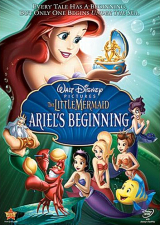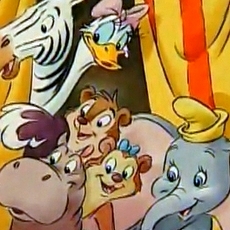In part two of our Little Mermaid interview series behind the sea-nes, Jeremie Noyer speaks to Ariel’s Beginning co-writer Robert Reece about writing for a mermaid!
Where do stories come from?
Well, just as with any form of art, there’s a mystery of creation that probably won’t ever be solved… And maybe that’s better that way. Yet, there’s always a way to unlock that mystery by talking with the creators themselves. And maybe Robert Reece is one of the best people to talk to, since he represents so many facets of artistic creation, from art and music to poetry and screenwriting.
Indeed, he has always been immersed in art. His mother, especially, an award-winning watercolorist, encouraged him to explore photography, drawing and music since he was a child, and he was early exposed to art through his parents’ gallery, the G. Lea Designs Arts Gallery. After a degree in Visual Communications and Cinema Studies, he worked as a photographer in Milan, Vienna and Hollywood. In parallel to that, Robert Reece has been a screenwriter and member of the Writer’s Guild of America West for 10 years. He has written projects for Warner Bros, Disney, Paramount, 20th Century Fox and Imagine Entertainment, and has worked with such acclaimed producers as John Davis, Robert Simonds and Donald De Line. Additionally, Robert wrote the screenplay for the independent film A Fare To Remember which premiered at the Santa Barbara Film Festival.
Additionally, his short fiction work in prose and verse has been published in magazines in the U.S. and abroad. When Robert isn’t writing, you’ll find him painting in his studio. His large, contemporary abstracts are included in private and commercial collections from the U.S. to Singapore.
From abstract art to Disney, it’s hard to capture Robert’s personality. And that’s precisely what makes him so interesting a personality and creative person, and certainly what led DisneyToon Studios to invite to him to write, along with Evan Spiliotopoulos, The Litte Mermaid: Ariel’s Beginning, a story full of emotion, music and dance. So, let’s be part his world for a moment and approach the mystery of the creation of this very story!
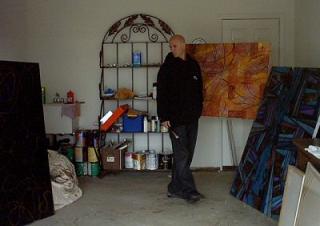
Animated Views: You’re a man of multiple skills. How would you introduce yourself?
Robert Reece: I would describe myself as a writer who paints as opposed to a painter who writes. It’s funny, though, because those that know me as a painter barely know that I am a writer. Around my hometown, I’m just a dorky dad that’s good at removing stink bugs (pinacate beetles) from the living room without smelling up the house.
AV: Do you see or do you make any connections between your different activities?
RR: There is a definite connection between all of my artistic pursuits. When I’m writing, I tend to think of words as paints on a palette. My process for writing is a very visual one (in my mind, anyway) and I try to splash the colors of those mental images onto the page with words. Similarly, when I’m painting or playing music, there are definite phrases and themes and stories that I’m trying to convey through abstract visual images or melodies. The process blends together for me and the approach to all of the artistic disciplines I endeavor to explore is with the heart and mind of a poet. Man, did that sound like pretentious art-speak or what? But it’s the truth.
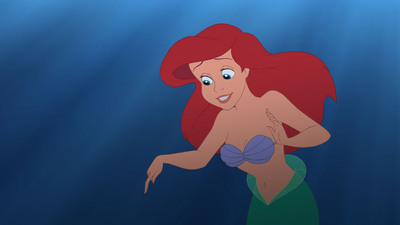
AV: How did you become a screenwriter?
RR: I started writing legitimate stories and poems when I was 7 or 8 years old. It’s all I ever wanted to do. I feel quite lucky that I knew that early on. I picked up a camera right after that. Maybe when I was 10 I had my hands on my first Nikon. I still use it. And I have all of my first stories as well. The paper is falling apart and the penmanship is illegible, but I’m telling you there are some twisted tales composed on those sheets. After many years of writing scripts (and untold millions of rejection slips) I finally got an agent and sold something. I can’t believe how long it took everyone to recognize how cool I am. Oh wait, that still hasn’t happened. Seriously, though, I was definitely not the over night success story. It took years of trying. You have to be somewhat impervious to negativity in this business.
AV: What led you to cinema, and to Disney, which seems very remote from abstract painting and poetry?
RR: Ultimately, cinema was the perfect marriage of all of my artistic passions. Music, story telling, visual imagery. Some people would say that Disney is far from art because it is commercial. That’s always going to be the balance in the movie business, though. It is art combined with commerce. Hopefully, you create something that you’re proud of and it has some artistic integrity. Also, you have to remember that although Disney is sometimes vilified for being a giant corporation, they provide the opportunity for thousands of artists to make a living doing what they love to do. From painters to actors to musicians to writers, etc. All of these fantastic creative people are making a living and raising their families by doing their art.
AV: How did you find yourself at Disney?
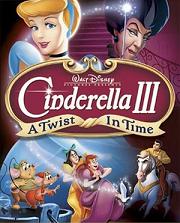 RR: I had been writing live-action scripts for the studios for a few years when my manager sent a script of mine over to Disney as a sample. I met with the executives a few times and we all seemed to gel quite well together. Eventually, I wrote the script for an additional movie starring The Aristocats. I was a huge fan of Thomas O’Malley as a character and jumped at the opportunity to see him and the others in another story. That script was well-received and fortunately it led to several other projects at Disney including Cinderella: A Twist In Time and eventually Little Mermaid: Ariel’s Beginning.
RR: I had been writing live-action scripts for the studios for a few years when my manager sent a script of mine over to Disney as a sample. I met with the executives a few times and we all seemed to gel quite well together. Eventually, I wrote the script for an additional movie starring The Aristocats. I was a huge fan of Thomas O’Malley as a character and jumped at the opportunity to see him and the others in another story. That script was well-received and fortunately it led to several other projects at Disney including Cinderella: A Twist In Time and eventually Little Mermaid: Ariel’s Beginning.
AV: Can you tell me about your work on Cinderella III?
RR: I came in to Cinderella after they were in production. They needed help with some of the scenes and I was lucky enough to get involved. It was exciting to be in the booth as the actors recorded the tracks and then eventually see the scenes I had a hand in shaping. I remember feeling very fortunate to work with such a talented team of artists, an experienced director in Frank Nissen and an unflappable and professional producer in Margot Pipkin. They gave me the perfect amount of direction while still allowing me the autonomy to create. I learned that there were literally hundreds of talented folks working on these films. Everyone does their very best work artistically and professionally and, above all, it was my impression that everyone felt it was an honor and a huge responsibility to be working with classic characters like Cinderella and Prince Charming. Most of all, we try to balance those classic characters with a story that has modern sensibilities and appeals to modern audiences. It can be a tight-rope act.
AV: Was the process different on Cinderella III to Ariel’s Beginning?
RR: It was a different group of folks, but the experience was equally satisfying. Director Peggy Holmes is very energetic and filled with life and she approaches things very artistically having come from a dance and music background. Producer Kendra Haaland is the perfect producer. She has a handle on everything and makes sure that the production comes in on time and on budget all with a smile on her face. She’s an excellent producer to work for.
AV: Can you give us an idea of your process on such a production? How did you write?
RR: Same as always. I write in my home-office, staring at the fountain outside my window hoping that the trickle of water will speak to me and tell me what to type.

AV: Your painting (Calliope, above) seems to balance order, in the geometrical shapes, and disorder/fantasy, with the random lines. Is it the same way in your writing?
RR: This kind of goes back to what I was talking about earlier. You have a “structure” that you are using as sort of a loose guideline but you still have to allow for discovery. When I paint, I start with a pencil sketch in a notebook that gets transferred onto a canvas. From there, I have to cut loose. Turn up Metallica and let it rip. In terms of writing, I suppose other writers use structure as a very strict guideline and maybe others don’t use structure at all. But for cinematic storytelling, there is order. It isn’t a random sequence of events. The events are put into a particular order by the artist. Choices are made to make a visual poem that, hopefully, elicits an emotional response. How that choice is made is probably different for every artist and every writer. Well, Disney hired me for a particular reason. I have a certain thing that I bring to the table as a writer that they’re looking to capture in the film. Hopefully, I’ve got all my creative juices flowing and I can come up with good material that they can use. If I went off track, Peggy and the other creative folks were there with input on where to change things.
AV: Did your background in visual arts help you in writing stories aimed at being very visual, because they’re ultimately animated?
RR: I guess my particular writing style is very visual so it lends itself well to animation. The artists and directors can read my pages and all see the same thing. At least something close to it. Another thing that’s great about animation is that the sky is the limit, visually. You can think of anything at all and they can animate it.
AV: What was your average working day like?
RR: The days could be a little hectic. We would have a story meeting in the morning to go over pages and scenes that I had worked on from the day before. After receiving input from Peggy and others on the creative team, I would go home and try to finish a set number of pages by Friday for the weekend read. Then on Monday, we’d have a story meeting and start the process over again.

AV: Did you have some material to guide you?
RR: There had been several scripts previous to when I came in. The script and the movie are living organisms that change and grow through the process. It’s amazing and actually a little magical when it works out well. I can’t remember if I really used those previous scripts as direct source material. Maybe more of a launch pad on certain scenes.
AV: How did you find working with your new director?
RR: I worked directly with Peggy. Some of the story meetings would last for hours and we’d seated right next to each other. It’s a collaborative effort and we’d even be in contact via email or phone when I wasn’t at the studio. Thankfully, when I’d go home and write, the pages came out well. As I mentioned before, she’s very fluid and energetic and her personality is very fun-loving and caring. She’s also decisive and knows what she wants, which is absolutely necessary when you’re under intense pressure to make a film. Yet, she never ever came off as dictatorial. From my perspective, she respected every artist’s input and everyone felt like they were part of a team with the same goal. Her love of music and dance permeates the entire movie. You see that the musical numbers are incredible.
AV: Did you work with your fellow screenwriter Evan Spiliotopoulos?
RR: I never worked directly with Evan. He came on board after I left Little Mermaid to work on another project. I’ve met him a number of times and seen his other work. He’s a gifted writer. Great with character, funny and very, very smart when it comes to story.
AV: Did you happen to meet and work with some other members of the crew?
RR: Every production takes up space at the studio. You see all of the artists and their work. It’s quite inspiring. They are all so damn good at what they do. It’s an interesting process because in animation there is an immediate visual feedback to your writing. You can write in live-action for years and never see a single frame get shot. In animation, I turn in pages, the artists do their thing and in a day or two, you get to see the images you had in your head. It’s amazing. I would take home some of their drawings and hang them around my office. So what I wrote would inform what they animated and then their artwork informed me. That back and forth creative input cycle is just cool.
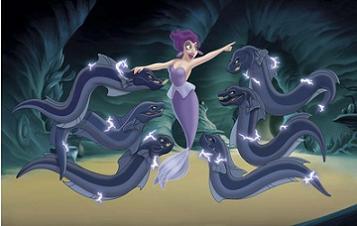
AV: Where did the original story idea of Ariel’s Beginning come from?
RR: I can’t quite recall where the original concept came from, but when I came into the project we started some of the concept over from scratch. Not re-inventing the wheel, but maybe half of the wheel.
AV: How do you imagine your stories?
RR: Man, that’s a tough question. I’m a very visual person and I actually see the movie in my mind as I’m writing it. The characters are definitely alive and three dimensional and I can only hope that they come across that way when I write them. Story-wise, there’s a certain outline, a path, that you’re trying to follow, but you can’t be so rigid about it that there isn’t any creativity or spontaneity left. Like any artistic process, hopefully your talent kicks in and you discover things along they way. As for what parts are mine, I concentrated a great deal on the emotional center of the film. I also concentrated on the relationships between Ariel and her sisters, the creation of Benjamin and his relationship with Marina Del Rey, the band members, etc. Really, the whole thing. Then Evan came on and he brought in his talent and perspective to the script.
AV: Speaking of characters, do you know why they chose to create a new villain, Marina, instead of developing the past of Ursula, why she was banished from Atlantica, etc?
RR: I’m not sure why they didn’t want to develop Ursula’s past other than the focus of the story was really about Ariel’s beginning, hence the title. Ursula didn’t factor in. Besides, Marina was a load of fun as a character even in the early stages. Everyone liked her penchant for flamboyant wardrobe. It was entertaining and gave us an exciting opportunity to present someone new to the audience.

AV: How did you approach Marina? What kind of a villain did you want her to be?
RR: There was a conscious effort to make Marina really more of a comedic, antagonistic character as opposed to the traditional “villain” that wants to rule the world and kill everyone in the process. She loathes Sebastian, which was fun for conflict as well, but she has no designs on ruling Atlantica (like Ursula) other than as a “grey eminence” – the power behind the thrown. As Ariel becomes more problematic for her, she just assumes that she’d have an “accident” at the end as well, but she doesn’t covet Triton’s position. Marina ended up being a hilarious and rather complex character because of that fact. She is driven by a certain amount of power at Triton’s side and merely wants it so that she can have fabulous things. She’s not excited about management or ruling the world.
AV: How did you create Benjamin and imagine his relationship to Marina?
RR: Benjamin came to me one night as I was writing a scene with Marina. His calm, soft-spoken nature played as a great counterpoint to her explosive personality. She wants to be absolutely fabulous, decked out in haute couture while Benjamin’s look remains pillowy and soft. He is innately good and works almost as a therapist for Marina much like any assistant does for a high-strung boss.

AV: The Little Mermaid “galaxy” is a very rich and complex one, including the original classic, the TV animated series, a sequel and, now, the Broadway musical. How did you deal with trying not to conflict with some stories that may have already been treated?
RR: There’s definitely a sense of responsibility when you’re working with a classic character that people know well and treasure. You have to study and get to know the characters individually, to capture their voices and maintain their integrity. At the same time, you can’t be afraid to explore new storylines with them and new emotions. As long as it stays true to who they are as individuals.
AV: The film is mostly about the way music enriches our lives. How did you approach that concept personally?
RR: I’m a music fanatic. I listen to everything from Rachmaninov to the Ramones. I also compose music on the piano. As a matter of fact, when I was in school I wrote more scores for student films than scripts. I just kind of fell into that job as a student, just like others became proficient at editing or camera. So, music permeates my daily life and I could relate on a very personal level to Ariel’s need to have music. It brings joy and love to our lives and the need to hear and express music is universal.
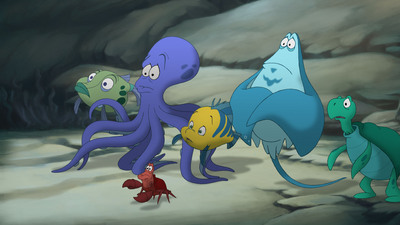
AV: There are always ideas that don’t make it into the final movie, and some of them are presented in the bonus features on the DVD. How is it when you have to let an idea go?
RR: When a movie is finished, it’s difficult to pinpoint why somethings made it and why others didn’t. It could be perhaps that a scene got cut during editing. Trust me, I had some incredible lines in there that would have made cinematic history. Why did they cut them? Why??? I’m joking, of course. Besides editing, it could have happened after I moved on and Evan worked on the script. There are many writers that are involved during the entire process of making the movie because it takes years and goes through many stages. Ultimately, Disney has to decide who gets what credit. In the end, I like to say that if something was in the movie and you liked it then I wrote it! If there was something you didn’t like, it must have been somebody else. All kidding aside, whatever combination of things came together, the script that Evan and I are credited with worked well and the movie is fantastic.
AV: What will you keep from the experience on Little Mermaid: Ariel’s Beginning?
RR: It was an honor to work on a project with such a talented crew. It was also my privilege to be a part of a movie that will bring joy to families around the world.
Painting: Calliope by Robert Reece. With our thanks for his time and kindness!


